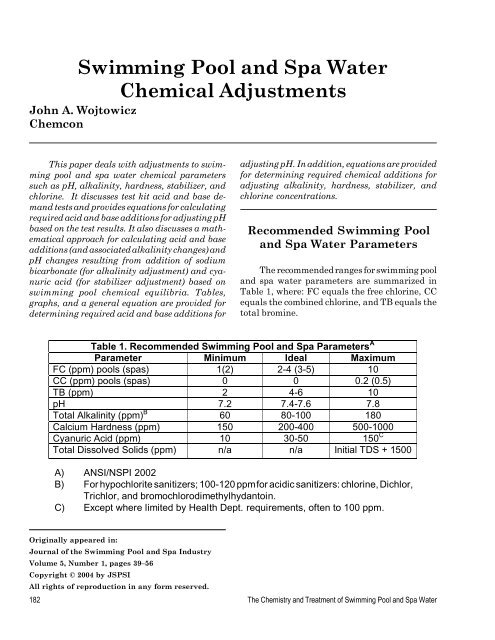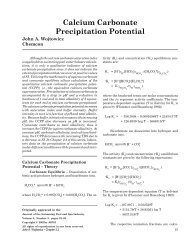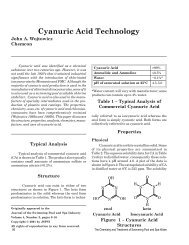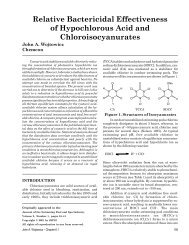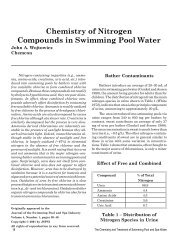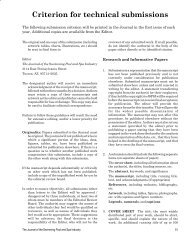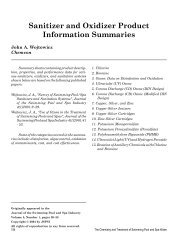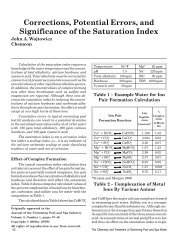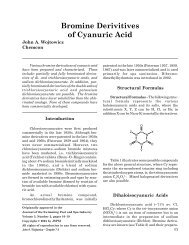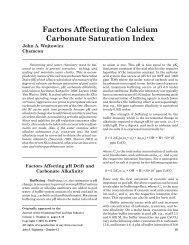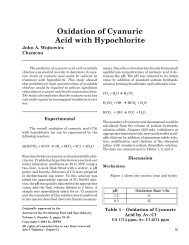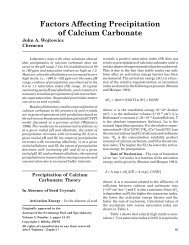Swimming Pool and Spa Water Chemical Adjustments - jspsi
Swimming Pool and Spa Water Chemical Adjustments - jspsi
Swimming Pool and Spa Water Chemical Adjustments - jspsi
Create successful ePaper yourself
Turn your PDF publications into a flip-book with our unique Google optimized e-Paper software.
<strong>Swimming</strong> <strong>Pool</strong> <strong>and</strong> <strong>Spa</strong> <strong>Water</strong><br />
<strong>Chemical</strong> <strong>Adjustments</strong><br />
John A. Wojtowicz<br />
Chemcon<br />
This paper deals with adjustments to swimming<br />
pool <strong>and</strong> spa water chemical parameters<br />
such as pH, alkalinity, hardness, stabilizer, <strong>and</strong><br />
chlorine. It discusses test kit acid <strong>and</strong> base dem<strong>and</strong><br />
tests <strong>and</strong> provides equations for calculating<br />
required acid <strong>and</strong> base additions for adjusting pH<br />
based on the test results. It also discusses a mathematical<br />
approach for calculating acid <strong>and</strong> base<br />
additions (<strong>and</strong> associated alkalinity changes) <strong>and</strong><br />
pH changes resulting from addition of sodium<br />
bicarbonate (for alkalinity adjustment) <strong>and</strong> cyanuric<br />
acid (for stabilizer adjustment) based on<br />
swimming pool chemical equilibria. Tables,<br />
graphs, <strong>and</strong> a general equation are provided for<br />
determining required acid <strong>and</strong> base additions for<br />
Originally appeared in:<br />
Journal of the <strong>Swimming</strong> <strong>Pool</strong> <strong>and</strong> <strong>Spa</strong> Industry<br />
Volume 5, Number 1, pages 39– 56<br />
Copyright © 2004 by JSPSI<br />
All rights of reproduction in any form reserved.<br />
adjusting pH. In addition, equations are provided<br />
for determining required chemical additions for<br />
adjusting alkalinity, hardness, stabilizer, <strong>and</strong><br />
chlorine concentrations.<br />
Recommended <strong>Swimming</strong> <strong>Pool</strong><br />
<strong>and</strong> <strong>Spa</strong> <strong>Water</strong> Parameters<br />
The recommended ranges for swimming pool<br />
<strong>and</strong> spa water parameters are summarized in<br />
Table 1, where: FC equals the free chlorine, CC<br />
equals the combined chlorine, <strong>and</strong> TB equals the<br />
total bromine.<br />
Table 1. Recommended <strong>Swimming</strong> <strong>Pool</strong> <strong>and</strong> <strong>Spa</strong> Parameters A<br />
Parameter Minimum Ideal Maximum<br />
FC (ppm) pools (spas) 1(2) 2-4 (3-5) 10<br />
CC (ppm) pools (spas) 0 0 0.2 (0.5)<br />
TB (ppm) 2 4-6 10<br />
pH 7.2 7.4-7.6 7.8<br />
Total Alkalinity (ppm) B<br />
60 80-100 180<br />
Calcium Hardness (ppm) 150 200-400 500-1000<br />
Cyanuric Acid (ppm) 10 30-50 150 C<br />
Total Dissolved Solids (ppm) n/a n/a Initial TDS + 1500<br />
A) ANSI/NSPI 2002<br />
B) For hypochlorite sanitizers; 100-120 ppm for acidic sanitizers: chlorine, Dichlor,<br />
Trichlor, <strong>and</strong> bromochlorodimethylhydantoin.<br />
C) Except where limited by Health Dept. requirements, often to 100 ppm.<br />
182 The Chemistry <strong>and</strong> Treatment of <strong>Swimming</strong> <strong>Pool</strong> <strong>and</strong> <strong>Spa</strong> <strong>Water</strong>
Factors Affecting <strong>Swimming</strong><br />
<strong>Pool</strong> <strong>and</strong> <strong>Spa</strong> <strong>Water</strong> Parameters<br />
Carbon Dioxide Loss – Carbon dioxide is<br />
continually evolved from swimming pool water<br />
because pools are normally supersaturated with<br />
carbon dioxide. This causes an upward drift in the<br />
pH <strong>and</strong> necessitates periodic pH adjustment with<br />
acid (Wojtowicz 1995a). In spas, the upward drift<br />
is accelerated by the higher temperature <strong>and</strong> use<br />
of aeration.<br />
Acidic Sanitizers – Acidic sanitizers such<br />
as chloroisocyanurates can significantly retard<br />
the rise in pH because of the large quantity of acid<br />
that they produce (Wojtowicz 1995b). Gaseous<br />
chlorine can completely offset the upward pH rise<br />
due to CO 2 loss <strong>and</strong> cause a downward drift.<br />
Alkaline Sanitizers – Alkaline sanitizers<br />
such as hypochlorites contain low levels of alkaline<br />
<strong>and</strong> basic substances that will augment the<br />
upward pH drift, but only to a small extent<br />
(Wojtowicz 1995b).<br />
<strong>Water</strong> Evaporation – <strong>Water</strong> used to replace<br />
that lost by evaporation will increase alkalinity<br />
<strong>and</strong> hardness.<br />
Filter Backwashing – <strong>Water</strong> used to replace<br />
that removed via filter backwashing can<br />
affect alkalinity <strong>and</strong> hardness depending on its<br />
composition.<br />
Analysis of <strong>Swimming</strong> <strong>Pool</strong> <strong>and</strong><br />
<strong>Spa</strong> <strong>Water</strong> via Test Kit<br />
A summary of swimming pool <strong>and</strong> spa water<br />
analysis via test kit is presented in Table 2.<br />
Table 2. Summary of <strong>Swimming</strong> <strong>Pool</strong> <strong>and</strong> <strong>Spa</strong> <strong>Water</strong> Parameter Measurement<br />
Parameter Measurement A<br />
Free Chlorine (FC) Reaction with DPD B produces a pink color proportional to<br />
concentration, which is quantified by comparison with a<br />
st<strong>and</strong>ard color scale. Alternatively, drop-wise titration with<br />
st<strong>and</strong>ard FAS C solution to extinction of the pink color can<br />
be used; the number of drops of FAS being proportional<br />
to the FC concentration.<br />
Combined Chlorine (CC) Addition of potassium iodide catalyzes reaction of CC with<br />
DPD <strong>and</strong> allows its determination.<br />
pH Treatment with phenol red indicator produces a color<br />
ranging from red (basic) to yellow (acidic). The pH is<br />
determined by comparison with a st<strong>and</strong>ard color scale.<br />
Acid Dem<strong>and</strong> The sample from pH measurement is titrated drop-wise<br />
with a st<strong>and</strong>ard dilute acid solution to the desired pH, the<br />
number of drops being proportional to the acid dem<strong>and</strong>.<br />
Base Dem<strong>and</strong> Similar to acid dem<strong>and</strong> except that a st<strong>and</strong>ard base<br />
solution is used.<br />
Total Alkalinity Titration with st<strong>and</strong>ard acid solution in the presence of<br />
mixed bromocresol green-methyl red indicator.<br />
Calcium Hardness A buffered sample is titrated with EDTA D in the presence<br />
of an indicator, eg, Eriochrome Black T.<br />
Cyanuric Acid (CA) Treatment of a sample with melamine solution produces<br />
turbidity (ie, a precipitate of melamine cyanurate) that is<br />
proportional to the CA concentration.<br />
A) Carried-out using test kits, eg, Taylor.<br />
B) N,N-Diethyl-p-phenylenediamine.<br />
C) Ferrous ammonium sulfate.<br />
D) Ethylenediamine tetra-acetic acid.<br />
John A. Wojtowicz – Chapter 8.1 183
<strong>Swimming</strong> <strong>Pool</strong> <strong>and</strong> <strong>Spa</strong> <strong>Water</strong><br />
pH Adjustment via Test Kit<br />
Analysis<br />
Acid Dem<strong>and</strong> – This test determines the<br />
amount of acid required to reduce the pH of<br />
swimming pool or spa water when it has exceeded<br />
the recommended range of 7.2 to 7.8 (see Table 1).<br />
The acid dem<strong>and</strong> test involves titration of a pool<br />
or spa water sample with acid to a desired pH;<br />
e.g., using a Taylor test kit. A st<strong>and</strong>ard acid<br />
solution (dilute sulfuric acid) is added dropwise to<br />
a known volume (44 mL) of pool or spa water<br />
containing a pH indicator (phenol red) until the<br />
desired pH is obtained as determined by the color<br />
change of the indicator. Tables are available to<br />
convert the number of drops of acid solution to<br />
volume of pool acid (muriatic acid, i.e., hydrochloric<br />
acid, HCl) to decrease the pH to the desired<br />
level (Taylor 2002). Based on these Tables, the<br />
quantity of muriatic acid (31.45% HCl) required<br />
can also be calculated using the following formula:<br />
V MA (fl. oz ) = 9.165•10 – 4 •N•V<br />
where: V MA (fl. oz ) equals the volume of muriatic<br />
acid, N equals the number of drops of acid dem<strong>and</strong><br />
reagent, <strong>and</strong> V equals the pool or spa<br />
volume (gals).<br />
Dry acid, i.e., sodium bisulfate, can also be<br />
used to lower pH. Tables are available for determining<br />
the quantity of bisulfate to add based on<br />
the number of drops of reagent <strong>and</strong> pool or spa<br />
volume. The quantity of sodium bisulfate also can<br />
be calculated using the following formula, which<br />
is based on these Tables:<br />
W BS (oz) = 1.148•10 – 3 •N•V/p<br />
where: W BS equals the weight of sodium bisulfate,<br />
N equals the number of drops of test kit acid<br />
dem<strong>and</strong> reagent, V equals the volume of pool or<br />
spa, <strong>and</strong> p equals the degree of purity of sodium<br />
bisulfate.<br />
Base Dem<strong>and</strong> – This test determines the<br />
amount of sodium carbonate (soda ash) required<br />
to increase the pH of pool or spa water when the<br />
pH has dropped below the recommended range of<br />
7.2 to 7.8, e.g., due to a high dose of gaseous<br />
chlorine or high usage of chloroisocyanurates.<br />
The base dem<strong>and</strong> test involves titration of a pool<br />
or spa water sample with base to a desired pH;<br />
e.g., using a Taylor test kit. A st<strong>and</strong>ard base<br />
solution (dilute sodium hydroxide) is added<br />
dropwise to a known volume (44 mL) of pool or spa<br />
water containing a pH indicator (phenol red)<br />
until the desired pH is obtained as determined by<br />
the color change of the indicator. Tables are<br />
available to convert the number of drops of base<br />
solution to weight of soda ash (sodium carbonate)<br />
to increase the pH to the desired level (Taylor<br />
2002). The quantity of 100% sodium carbonate<br />
required can also be calculated using the following<br />
formula:<br />
W SC (oz) = 5.12•10 – 4 •N•V<br />
where: W SC equals the weight of sodium carbonate,<br />
N equals the number of drops of base dem<strong>and</strong><br />
reagent, <strong>and</strong> V equals the volume of pool or spa<br />
water (gals).<br />
Calculation of <strong>Swimming</strong> <strong>Pool</strong><br />
<strong>and</strong> <strong>Spa</strong> <strong>Water</strong> <strong>Chemical</strong><br />
Parameters <strong>and</strong> <strong>Adjustments</strong><br />
Computer Assisted Calculations<br />
The basic data <strong>and</strong> equations for calculating<br />
certain changes in water chemistry have been<br />
published in previous issues of the journal (e.g.,<br />
see Wojtowicz 1995b, 1995c, 2001, <strong>and</strong> 2002). The<br />
changes include: acid <strong>and</strong> base requirements for<br />
adjusting pH <strong>and</strong> pH changes on addition of<br />
chlorine, sodium bicarbonate, <strong>and</strong> cyanuric acid.<br />
The input data for the calculations are: pool or spa<br />
volume, water temperature, total dissolved solids,<br />
initial <strong>and</strong> final pH, total alkalinity, cyanuric<br />
acid, boron, <strong>and</strong> av. Cl. In the case of carbon<br />
dioxide loss calculations, additional data are necessary<br />
such as pool or spa surface to volume ratio,<br />
pumping rate, <strong>and</strong> pump duty cycle.<br />
Variables, Constants, <strong>and</strong> Conversion<br />
Factors<br />
Various conversion factors <strong>and</strong> variable sym-<br />
184 The Chemistry <strong>and</strong> Treatment of <strong>Swimming</strong> <strong>Pool</strong> <strong>and</strong> <strong>Spa</strong> <strong>Water</strong>
ols are used in the following discussions <strong>and</strong> are<br />
summarized in Table 3.<br />
pH Adjustment<br />
Table 3. Summary of Variables, Constants, <strong>and</strong> Conversion Factors<br />
Variables Conversion Factors<br />
V = pool or spa volume (gal) 28.35 g/oz<br />
TA = total alkalinity (ppm) 29.57 mL/fl. oz<br />
d = density (g/mL) 1000 mg/g<br />
p = degree of purity (% assay/100) 436.5 g/lb<br />
Constants 3.7854 L/gal<br />
Equivalent wt. of CaCO3 (50)<br />
Decreasing pH with Muriatic Acid –<br />
Addition of muriatic acid lowers the pH of swimming<br />
pool water because it is highly ionized,<br />
thereby increasing the concentration of hydrogen<br />
ions (H + ) which suppresses ionization of the respective<br />
acidic species resulting in decreased<br />
concentrations of the alkaline ions: carbonate,<br />
bicarbonate, cyanurate, <strong>and</strong> borate, i.e., the equilibria<br />
below are shifted to the right.<br />
2– + –<br />
CO + H HCO 3<br />
3<br />
– + HCO + H H CO H O + CO 3<br />
2 3 2 2<br />
H 2 Cy – + H + H 3 Cy<br />
– + B(OH) + H H BO + H O<br />
4<br />
3 3 2<br />
The required quantity of acid is readily calculable<br />
from the decrease in calculated total alkalinity<br />
at the new pH. Each mol of added acid<br />
neutralizes one mol of total alkalinity.<br />
Tables 3A to 6A contain calculated values of<br />
muriatic acid required to reduce pHs in the 7.8 to<br />
8.2 range to 7.2 at different total alkalinities (80<br />
to 210 ppm) <strong>and</strong> cyanuric acid levels (50 to 200<br />
ppm). The data are also shown graphically in<br />
Figures 1 to 4. The graphs show that the quantity<br />
of acid varies linearly with total alkalinity at a<br />
given starting pH. The conditions used for the<br />
calculations are: 80°F, 1000 ppm TDS, 3 ppm av.<br />
Cl, <strong>and</strong> 10,000 gals pool volume.<br />
Multiple linear regression analysis of all of<br />
the data in Tables 3A to 6A was performed using<br />
the following equation form involving one dependent<br />
variable (V MA ) <strong>and</strong> three independent variables<br />
(pH, TA, <strong>and</strong> CA):<br />
V MA = a + b(pH) + c(TA) + d(CA)<br />
where: V MA equals the volume of 31.45% muriatic<br />
acid (fl oz), TA equals the total alkalinity (ppm),<br />
<strong>and</strong> CA equals the cyanuric acid (ppm). The<br />
regression analysis showed an excellent correlation<br />
coefficient (0.997) <strong>and</strong> a very low st<strong>and</strong>ard<br />
deviation (0.02), resulting in the following equation:<br />
V MA = – 237.34 + 29.894(pH) + 0.244(TA) + 0.1276(CA)<br />
This equation estimates the values in Tables 3A<br />
to 6A to within ± 2% on average.<br />
Borate will affect the calculated quantity of<br />
acid. For example, the presence of 100 ppm of<br />
boric acid (17.5 ppm boron) will increase the<br />
calculated quantity of muriatic acid (required to<br />
reduce pH from 8.2 to 7.2) from 62.1 fl. oz to 78.2<br />
fl. oz at 100 ppm CA <strong>and</strong> 170 ppm total alkalinity.<br />
John A. Wojtowicz – Chapter 8.1 185
Total Alk.<br />
Table 3A. Volume (fl. oz) of 31.45% Muriatic Acid<br />
to Reduce pH to 7.2; CA 50 ppm<br />
ppm 7.8 7.9 8 8.1 8.2<br />
70 22.1 24.0 25.5 26.9 28.1<br />
80 24.2 26.3 28.0 29.5 30.8<br />
90 26.4 28.6 30.4 32.1 33.5<br />
100 28.5 30.9 32.9 34.6 36.2<br />
110 30.7 33.2 35.4 37.2 38.9<br />
120 32.8 35.5 37.8 39.8 41.6<br />
130 34.9 37.8 40.3 42.4 44.3<br />
140 37.1 40.1 42.7 45.0 47.1<br />
150 39.2 42.4 45.2 47.6 49.8<br />
186 The Chemistry <strong>and</strong> Treatment of <strong>Swimming</strong> <strong>Pool</strong> <strong>and</strong> <strong>Spa</strong> <strong>Water</strong>
Total Alk.<br />
Table 4A. Volume (fl. oz) of 31.45% Muriatic Acid<br />
to Reduce pH to 7.2; CA 100 ppm<br />
ppm 7.8 7.9 8 8.1 8.2<br />
90 32.0 34.7 36.9 38.8 40.4<br />
100 34.2 37.0 39.4 41.4 43.1<br />
110 36.3 39.3 41.8 44.0 45.8<br />
120 38.4 41.6 44.3 46.6 48.5<br />
130 40.6 43.9 46.7 49.1 51.3<br />
140 42.7 46.2 49.2 51.7 54.0<br />
150 44.9 48.5 51.6 54.3 56.7<br />
160 47.0 50.8 54.1 56.9 59.4<br />
170 49.1 53.2 56.6 59.5 62.1<br />
John A. Wojtowicz – Chapter 8.1 187
Total Alk.<br />
Table 5A. Volume (fl. oz) of 31.45% Muriatic Acid<br />
to Reduce pH to 7.2; CA 150 ppm<br />
ppm 7.8 7.9 8 8.1 8.2<br />
110 42.0 45.4 48.3 50.7 52.8<br />
120 44.1 47.7 50.8 53.3 55.5<br />
130 46.2 50.0 53.2 55.9 58.2<br />
140 48.4 52.3 55.7 58.5 60.9<br />
150 50.5 54.7 58.1 61.1 63.6<br />
160 52.7 57.0 60.6 63.6 66.3<br />
170 54.8 59.3 63.0 66.2 69.0<br />
180 56.9 61.6 65.5 68.8 71.7<br />
190 59.1 63.9 67.9 71.4 74.4<br />
188 The Chemistry <strong>and</strong> Treatment of <strong>Swimming</strong> <strong>Pool</strong> <strong>and</strong> <strong>Spa</strong> <strong>Water</strong>
Total Alk.<br />
Table 6A. Volume (fl. oz) of 31.45% Muriatic Acid<br />
to Reduce pH to 7.2; CA 200 ppm<br />
ppm 7.8 7.9 8 8.1 8.2<br />
130 51.9 56.2 59.7 62.6 65.1<br />
140 54.0 58.5 62.1 65.2 67.8<br />
150 56.2 60.8 64.6 67.8 70.5<br />
160 58.3 63.1 67.1 70.4 73.2<br />
170 60.5 65.4 69.5 73.0 75.9<br />
180 62.6 67.7 72.0 75.6 78.6<br />
190 64.7 70.0 74.4 78.1 81.4<br />
200 66.9 72.3 76.9 80.7 84.1<br />
210 69.0 74.6 79.3 83.3 86.8<br />
John A. Wojtowicz – Chapter 8.1 189
Tables 3B to 6B contain calculated<br />
values of muriatic acid required<br />
to reduce pHs in the 7.3 to 7.7 range<br />
to 7.2 at different total alkalinities<br />
(80 to 210 ppm) <strong>and</strong> cyanuric acid<br />
levels (50 to 200 ppm). These Tables<br />
are useful for determining the quantity<br />
of muriatic acid required to reduce<br />
pH from the 7.8 to 8.2 range to<br />
intermediate values in the 7.3 to7.7<br />
range. For example, to calculate the<br />
quantity of muriatic acid required to<br />
reduce pH from 8.2 to7.5, one would<br />
subtract the quantity of acid to reduce<br />
pH from 7.5 to 7.2 from that<br />
required to reduce pH from 8.2 to<br />
7.2.<br />
Decreasing pH with Sulfuric<br />
Acid – The above equation also<br />
works equally well for 38.5% sulfuric<br />
acid (d = 1.29 g/mL).<br />
Decreasing pH with Sodium<br />
Bisulfate – It will require 1.32 oz of<br />
95% sodium bisulfate to provide the<br />
same pH reduction as one fl. oz of<br />
31.45% muriatic acid. Bisulfate (i.e.,<br />
bisulfate ion) lowers pH by reacting<br />
with hydroxyl ion <strong>and</strong> is converted<br />
to sulfate ion.<br />
– – 2– HSO + OH → SO4 + H2O 4<br />
Decreasing pH with Carbon<br />
Dioxide – By contrast with mineral<br />
acids (hydrochloric <strong>and</strong> sulfuric) <strong>and</strong><br />
bisulfate, carbon dioxide decreases<br />
pH (without affecting alkalinity) by<br />
increasing the concentration of carbonic<br />
acid.<br />
Total Alk.<br />
Table 3B. Volume (fl. oz) of 31.45% Muriatic Acid<br />
to Reduce pH to 7.2; CA 50 ppm<br />
ppm 7.3 7.4 7.5 7.6 7.7<br />
70 5.6 10.2 14.0 17.2 19.9<br />
80 6.2 11.2 15.4 18.9 21.8<br />
90 6.7 12.3 16.8 20.6 23.8<br />
100 7.3 13.3 18.2 22.3 25.7<br />
110 7.9 14.3 19.6 24.0 27.6<br />
120 8.4 15.4 21.0 25.7 29.6<br />
130 9.0 16.4 22.4 27.4 31.5<br />
140 9.6 17.4 23.8 29.1 33.4<br />
150 10.2 18.4 25.2 30.8 35.4<br />
Total Alk.<br />
Table 4B. Volume (fl. oz) of 31.45% Muriatic Acid<br />
to Reduce pH to 7.2; CA 100 ppm<br />
ppm 7.3 7.4 7.5 7.6 7.7<br />
90 8.1 14.8 20.3 25.0 28.8<br />
100 8.6 15.8 21.7 26.7 30.8<br />
110 9.2 16.8 23.1 28.4 32.7<br />
120 9.8 17.8 24.5 30.1 34.6<br />
130 10.3 18.9 25.9 31.8 36.6<br />
140 10.9 19.9 27.3 33.5 38.5<br />
150 11.5 20.9 28.7 35.2 40.5<br />
160 12.0 22.0 30.1 36.8 42.4<br />
170 12.6 23.0 31.5 38.5 44.3<br />
Total Alk.<br />
Table 5B. Volume (fl. oz) of 31.45% Muriatic Acid<br />
to Reduce pH to 7.2; CA 150 ppm<br />
ppm 7.3 7.4 7.5 7.6 7.7<br />
110 10.5 19.3 26.6 32.7 37.8<br />
120 11.1 20.3 28.0 34.4 39.7<br />
130 11.7 21.4 29.4 36.1 41.7<br />
140 12.2 22.4 30.8 37.8 43.6<br />
150 12.8 23.4 32.2 39.5 45.5<br />
160 13.4 24.5 33.6 41.2 47.5<br />
170 13.9 25.5 35.0 42.9 49.4<br />
180 14.5 26.5 36.4 44.6 51.3<br />
190 15.1 27.6 37.8 46.3 53.3<br />
Increasing pH with Sodium<br />
Carbonate – As discussed earlier,<br />
Table 6B. Volume (fl. oz) of 31.45% Muriatic Acid<br />
swimming pool <strong>and</strong> spa pH tends to Total Alk. to Reduce pH to 7.2; CA 200 ppm<br />
drift upward. Thus, acid addition is ppm 7.3 7.4 7.5 7.6 7.7<br />
typically necessary to adjust the pH 130 13.0 23.9 33.0 40.5 46.7<br />
to the recommended range. By con- 140 13.6 24.9 34.3 42.2 48.7<br />
trast, pools treated with chlorine<br />
will offset the upward pH drift due<br />
to CO loss because of the acidity<br />
2<br />
introduced, which lowers pH <strong>and</strong><br />
decreases alkalinity. This will necessitate<br />
addition of soda ash, which<br />
150<br />
160<br />
170<br />
180<br />
190<br />
200<br />
210<br />
14.1<br />
14.7<br />
15.3<br />
15.8<br />
16.4<br />
17.0<br />
17.6<br />
25.9<br />
27.0<br />
28.0<br />
29.0<br />
30.0<br />
31.1<br />
32.1<br />
35.7<br />
37.1<br />
38.5<br />
39.9<br />
41.3<br />
42.7<br />
44.1<br />
43.9<br />
45.6<br />
47.3<br />
49.0<br />
50.7<br />
52.3<br />
54.0<br />
50.6<br />
52.5<br />
54.5<br />
56.4<br />
58.4<br />
60.3<br />
62.2<br />
190 The Chemistry <strong>and</strong> Treatment of <strong>Swimming</strong> <strong>Pool</strong> <strong>and</strong> <strong>Spa</strong> <strong>Water</strong>
increases both pH <strong>and</strong> alkalinity. Dissolution of<br />
sodium carbonate in water produces hydroxyl<br />
<strong>and</strong> bicarbonate ions:<br />
2– – –<br />
CO + H2O HCO + OH 3<br />
3<br />
The hydroxyl ions decrease the concentration<br />
of hydrogen ions via the equilibrium:<br />
H 2 O H + + OH – . This raises the pH, causing<br />
increased ionization of carbonic, cyanuric, <strong>and</strong><br />
boric acids producing bicarbonate, cyanurate, <strong>and</strong><br />
borate ions, i.e., the reverse of the reactions when<br />
acid is added as shown in the previous section.<br />
The quantity of sodium carbonate required<br />
is calculable based on the increase in alkalinity at<br />
the higher pH. Tables 7– 10 contain calculated<br />
values of sodium carbonate required to raise pH<br />
to 7.8 from initial pHs of 7.2– 7.7. The conditions<br />
for the calculations were: 80°F, 3 ppm av. Cl, 1000<br />
ppm TDS, total alkalinity of 70– 210, <strong>and</strong> CA of<br />
50– 200 ppm. Plots of the data are shown in<br />
Figures 5– 8. They show that the required quantity<br />
of sodium carbonate varies linearly with total<br />
alkalinity at a given pH <strong>and</strong> CA concentration.<br />
Multiple linear regression analysis of all the<br />
T. Alk. Table 7. Weight (oz) of Sodium Carbonate to Increase pH to 7.8: CA 50 ppm<br />
ppm 7.2 7.3 7.4 7.5 7.6 7.7<br />
70 26.0 19.5 14.0 9.5 5.7 2.6<br />
80 28.6 21.3 15.3 10.4 6.3 2.8<br />
90 31.1 23.2 16.6 11.2 6.8 3.1<br />
100 33.6 25.0 17.9 12.1 7.3 3.3<br />
110 36.1 26.9 19.2 13.0 7.8 3.6<br />
120 38.6 28.7 20.6 13.9 8.3 3.8<br />
130 41.2 30.5 21.9 14.7 8.9 4.0<br />
140 43.7 32.4 23.2 15.6 9.4 4.3<br />
150 46.2 34.2 24.5 16.5 9.9 4.5<br />
John A. Wojtowicz – Chapter 8.1 191
T. Alk. Table 8. Weight (oz) of Sodium Carbonate to Increase pH to 7.8: CA 100 ppm<br />
ppm 7.2 7.3 7.4 7.5 7.6 7.7<br />
90 37.8 28.3 20.4 13.8 8.3 3.8<br />
100 40.3 30.1 21.7 14.6 8.8 4.0<br />
110 42.8 32.0 23.0 15.5 9.4 4.2<br />
120 45.3 33.8 24.3 16.4 9.9 4.5<br />
130 47.8 35.6 25.6 17.3 10.4 4.7<br />
140 50.3 37.5 26.9 18.1 10.9 5.0<br />
150 52.9 39.3 28.2 19.0 11.4 5.2<br />
160 55.4 41.2 29.5 19.9 12.0 5.4<br />
170 57.9 43.0 30.8 20.8 12.5 5.7<br />
192 The Chemistry <strong>and</strong> Treatment of <strong>Swimming</strong> <strong>Pool</strong> <strong>and</strong> <strong>Spa</strong> <strong>Water</strong>
T. Alk. Table 9. Weight (oz) of Sodium Carbonate to Increase pH to 7.8: CA 150 ppm<br />
ppm 7.2 7.3 7.4 7.5 7.6 7.7<br />
110 49.5 37.1 26.7 18.1 10.8 4.9<br />
120 52.0 38.9 28.0 18.9 11.3 5.2<br />
130 54.5 40.7 29.3 19.8 11.9 5.4<br />
140 57.0 42.6 30.6 20.7 12.4 5.6<br />
150 59.5 44.4 31.9 21.5 12.9 5.9<br />
160 62.0 46.3 33.2 22.4 13.5 6.1<br />
170 64.6 48.1 34.5 23.3 14.0 6.3<br />
180 67.1 50.0 35.8 24.2 14.5 6.6<br />
190 69.6 51.8 37.1 25.0 15.1 6.8<br />
John A. Wojtowicz – Chapter 8.1 193
T. Alk. Table 10. Weight (oz) of Sodium Carbonate to Increase pH to 7.8: CA 200 ppm<br />
ppm 7.2 7.3 7.4 7.5 7.6 7.7<br />
130 61.2 45.9 33.0 22.3 13.4 6.1<br />
140 63.7 47.7 34.3 23.2 14.0 6.3<br />
150 66.2 49.5 35.6 24.1 14.5 6.6<br />
160 68.7 51.4 36.9 24.9 15.0 6.8<br />
170 71.2 53.2 38.3 25.8 15.5 7.0<br />
180 73.7 55.1 39.6 26.7 16.1 7.3<br />
190 76.3 56.9 40.9 27.6 16.6 7.5<br />
200 78.8 58.8 42.2 28.4 17.1 7.7<br />
210 81.3 60.6 43.5 29.3 17.6 8.0<br />
194 The Chemistry <strong>and</strong> Treatment of <strong>Swimming</strong> <strong>Pool</strong> <strong>and</strong> <strong>Spa</strong> <strong>Water</strong>
data in Tables 7– 10 did not yield a satisfactory<br />
predictive equation as in the case of acid addition,<br />
because the data was not linear with respect to<br />
pH. Therefore, the data from each Table was<br />
regressed separately using the following equation<br />
form consisting of the dependent variable<br />
W SC (oz sodium carbonate) <strong>and</strong> the independent<br />
variable pH:<br />
W SC = (A 1 + A 2 •F) + (B 1 + B 2 •F)•pH + (C 1 + C 2 •F)•pH 2<br />
where: A 1 , B 1 , <strong>and</strong> C 1 are regression constants<br />
<strong>and</strong> A 2 , B 2 , <strong>and</strong> C 2 are constants for extrapolating<br />
total alkalinity, <strong>and</strong> F equals (TA a – TA o )/10<br />
where TA a is the actual total alkalinity, <strong>and</strong> TA o<br />
is the lowest total alkalinity for a given CA level<br />
<strong>and</strong> is equal to 70, 90, 110, <strong>and</strong> 130 for the data in<br />
Tables 7– 10, respectively. The constants are summarized<br />
in Table 11. These equations estimate<br />
the values in Tables 7– 10 to within ±2% on average.<br />
Because of chlorine’s propensity for lowering<br />
pH, pool service companies using chlorine for<br />
sanitization maintain pH at or above 7.8. <strong>Pool</strong>s<br />
are treated once a week, <strong>and</strong> typically, the av. Cl<br />
averages about 3 ppm before chlorination. The<br />
water is treated with about 8 oz chlorine/10,000<br />
gal, which is equivalent to 6 ppm av. Cl. Total<br />
alkalinity <strong>and</strong> stabilizer are maintained at about<br />
100 ppm. The total alkalinity will be reduced by<br />
4.23 ppm. If the pH is at 8.0 when the chlorine is<br />
added, it will decrease to 7.54. Raising the pH to<br />
7.8 will require 13.4 oz of soda ash <strong>and</strong> will raise<br />
the total alkalinity by 9.4 ppm. When all of the<br />
added av. Cl has decomposed to HCl, the total<br />
alkalinity will be reduced by an additional 4.23<br />
ppm. Thus, the net change in total alkalinity will<br />
be about +0.9 ppm.<br />
If the quantity of soda ash is just sufficient to<br />
neutralize all of the acidity due to chlorine, there<br />
should be no net change in alkalinity as shown<br />
below <strong>and</strong> will require 1.5 lb of soda ash per pound<br />
of chlorine or 12.0 oz in the above example.<br />
Cl 2 + H 2 O → HOCl + HCl<br />
HOCl → HCl + 0.5O 2<br />
Na 2 CO 3 + 2HCl → 2NaCl + CO 2 + H 2 O<br />
Overall: Na 2 CO 3 + Cl 2 → 2NaCl + CO 2 + 0.5O 2<br />
However, pool alkalinity can still change<br />
due to the effects of filter backwashing <strong>and</strong> makeup<br />
water.<br />
Increasing pH with Sodium Hydroxide<br />
– Addition of sodium hydroxide (caustic soda) to<br />
water raises pH by increasing the concentration<br />
hydroxyl ions. In the above example, it would<br />
require 21.7 fl. oz of 30% sodium hydroxide to<br />
increase the pH to 7.8. This would raise the total<br />
alkalinity from 95.8 to 104.2 ppm. Decomposition<br />
of all of the added chlorine would reduce the total<br />
alkalinity back to its original value of 100 ppm,<br />
thus no change in alkalinity would occur <strong>and</strong> is in<br />
agreement with the following reaction stoichiometry<br />
obtained on substitution of sodium hydroxide<br />
in place of soda ash in the above reaction<br />
sequence:<br />
2NaOH + Cl 2 → 2NaCl + H 2 O + 0.5O 2<br />
Alkalinity Changes after pH<br />
<strong>Adjustments</strong><br />
Decrease in Alkalinity after Mineral<br />
Acid Addition – Mineral acid (i.e., hydrochloric<br />
or sulfuric) addition for pH adjustment lowers<br />
alkalinity by reacting with bicarbonate, carbonate,<br />
cyanurate, <strong>and</strong> borate (if present) ions as<br />
Table 11. Summary of Constants for Calculating Soda Ash Addition<br />
CA A1 A2 B1 B2 C1 C2<br />
50 2732.097 302.340 -683.781 -76.358 42.768 4.821<br />
100 3939.389 301.702 -985.481 -76.189 61.607 4.810<br />
150 5144.099 301.527 -1286.436 -76.149 80.393 4.808<br />
200 6336.031 302.088 -1584.076 -76.291 98.964 4.817<br />
John A. Wojtowicz – Chapter 8.1 195
discussed earlier. The decrease in total alkalinity<br />
(∆TA) is calculable from the quantity of acid<br />
added.<br />
∆TA = (fl. oz acid)•29.57•d•p•1000•50/<br />
(EW•V•3.7854)<br />
where: d equals 1.16 for muriatic acid <strong>and</strong> 1.29 for<br />
sulfuric acid, p equals 0.3145 for muriatic acid<br />
<strong>and</strong> 0.385 for sulfuric acid, EW is equivalent<br />
weight – 36.46 for hydrochloric acid <strong>and</strong> 49.04 for<br />
sulfuric acid. The above calculation yields similar<br />
results (to within 1%) for each acid. Thus, one<br />
quart (i.e., 32 fl oz) of 31.45% muriatic acid <strong>and</strong><br />
38.5% sulfuric acid added to 10,000 gal of pool<br />
water reduces alkalinity by 12.5 <strong>and</strong> 12.7 ppm,<br />
respectively, as calculated by the following condensed<br />
formulas:<br />
∆TA = 3912.0•V MA /V<br />
∆TA = 3962.8•V SA /V<br />
where: V MA equals the volume (fl oz) of muriatic<br />
acid <strong>and</strong> V SA equals the volume (fl oz) of sulfuric<br />
acid.<br />
Decrease in Alkalinity after Sodium<br />
Bisulfate Addition – The change in total alkalinity<br />
when sodium bisulfate is used for pH adjustment<br />
is calculated as follows:<br />
∆TA = W BS •28.35•p•1000•50/(120•V•3.7854)<br />
= 3120.5•W BS •p/V<br />
where: W BS equals the weight (oz) of sodium<br />
bisulfate, 120 is the molecular weight of sodium<br />
bisulfate. Assuming a degree of purity of 0.95 (i.e.,<br />
95% purity), each pound (i.e., 16 oz) of sodium<br />
bisulfate added to 10,000 gal of pool water will<br />
reduce total alkalinity by 4.7 ppm.<br />
Increase In Alkalinity after Sodium Carbonate<br />
Addition – The increase in total alkalinity<br />
(∆TA) resulting from addition of sodium carbonate<br />
(soda ash) can be calculated using the<br />
following formula:<br />
∆TA = W SC •28.35•1000•50/(53•V•3.7854•p)<br />
= 7065.4•W SC /(V•p)<br />
where: W SC equals the weight (oz) of sodium<br />
carbonate, <strong>and</strong> 53 equals the equivalent weight of<br />
sodium carbonate. Assuming a typical degree of<br />
purity of 0.998 (i.e., 99.8% purity), each pound<br />
(i.e., 16 oz) of soda ash added to 10,000 gals of pool<br />
water will increase the total alkalinity by 11.3<br />
ppm.<br />
Alkalinity Adjustment<br />
All tap <strong>and</strong> well water contain varying<br />
amounts of alkalinity depending on the source. In<br />
new pools the alkalinity may require adjustment<br />
to the recommended range (see Table 1). In established<br />
pools, makeup water to replace evaporation<br />
losses will increase the pool or spa alkalinity.<br />
In addition, alkaline sanitizers will increase alkalinity<br />
to a small extent, whereas acidic sanitizers<br />
will decrease alkalinity to a significant<br />
extent (Wojtowicz 1995b). High alkalinity is lowered<br />
by acid addition whereas low alkalinity is<br />
increased with sodium bicarbonate.<br />
Increasing Alkalinity with Sodium Bicarbonate<br />
– Sodium bicarbonate is used to increase<br />
total alkalinity. Addition of sodium bicarbonate<br />
to pool water will increase the concentration<br />
of bicarbonate ions, which will repress ionization<br />
of carbonic acid resulting in a lower hydrogen<br />
ion concentration <strong>and</strong> a higher pH.<br />
H 2 CO 3<br />
– +<br />
HCO + H 3<br />
However, the effect is very small. For example,<br />
increasing the total alkalinity by 20 ppm with<br />
sodium bicarbonate in pool water at 80°F, pH 7.5,<br />
total alkalinity 80 ppm, cyanuric acid 100 ppm,<br />
av. Cl 3 ppm, <strong>and</strong> TDS 1000 ppm will increase the<br />
pH to only 7.55.<br />
The quantity of sodium bicarbonate (W SB<br />
(lb)) can be calculated using the following equation:<br />
W SB = ∆TA•84•V•3.7854/(50•!000•453.6•p)<br />
= 1.40•10 – 5 •∆TA•V/p<br />
where: ∆TA equals the increase in total alkalinity<br />
(ppm), 84 equals the molecular weight of sodium<br />
bicarbonate, <strong>and</strong> p is typically 1.0, i.e., 100%<br />
assay. Tables are available showing dosages for<br />
various water volumes.<br />
196 The Chemistry <strong>and</strong> Treatment of <strong>Swimming</strong> <strong>Pool</strong> <strong>and</strong> <strong>Spa</strong> <strong>Water</strong>
Decreasing Alkalinity with Mineral Acid<br />
– The quantity of mineral acid necessary to reduce<br />
total alkalinity (TA) by a specified amount<br />
can be calculated using the following equations<br />
obtained by rearrangement of equations used<br />
earlier.<br />
V MA = 2.556•10 – 4 •(∆TA) •V<br />
V SA = 2.523•10 – 4 •(∆TA) •V<br />
where: V MA equals the volume (fl oz) of 31.45%<br />
muriatic acid, V SA equals the volume (fl oz) of<br />
sulfuric acid. Reduction of total alkalinity by 10<br />
ppm requires 1.6 pints of muriatic acid.<br />
Decreasing Alkalinity with Sodium<br />
Bisulfate – Similarly, the earlier equation can be<br />
rearranged to give the quantity of bisulfate (W BS<br />
oz) necessary to reduce total alkalinity by a specified<br />
amount.<br />
W BS = 3.205•10 – 4 •(∆TA) •V/p<br />
Hardness Adjustment<br />
Increasing Hardness – All source water<br />
contains some calcium hardness. If necessary,<br />
the calcium hardness (CH) can be adjusted to the<br />
recommended range by the addition of calcium<br />
chloride (typically the dihydrate CaCl 2 •2H 2 O).<br />
The required dosage is readily calculable using<br />
the following equation:<br />
W CC = ∆CH•V•3.7854•147/(100•1000•453.6•p)<br />
= 1.227•10 – 5 •∆CH•V/p<br />
where: W CC equals lbs of calcium chloride dihydrate,<br />
DCH equals the increase in calcium hardness<br />
(ppm), 147 equals the molecular weight of<br />
calcium chloride dihydrate, 100 equals the molecular<br />
weight of calcium carbonate, <strong>and</strong> p equals<br />
the degree of purity of calcium chloride dihydrate<br />
(typically 0.98). Raising calcium hardness (expressed<br />
as ppm calcium carbonate) by 10 ppm<br />
requires 1.25 lb of 98% calcium chloride dihydrate<br />
per 10,000 gals of pool water. Tables are<br />
available showing dosages for various water volumes.<br />
Decreasing Hardness – Alkaline sanitizers<br />
such as calcium hypochlorite add small amounts<br />
of calcium hardness to the water (Wojtowicz<br />
1995b). Makeup water to replace evaporation<br />
losses also adds calcium hardness to pool or spa<br />
water. Makeup water used to replace water removed<br />
by backwashing can reduce calcium hardness<br />
if its hardness is lower. Thus, frequent<br />
backwashing can keep hardness in the recommended<br />
range.<br />
Stabilizer Adjustment<br />
Increasing Stabilizer Concentration –<br />
The stabilizer concentration is adjusted by addition<br />
of cyanuric acid (CA). In a new pool, the<br />
stabilizer concentration can be adjusted to 50<br />
ppm by addition of 4.2 lb of cyanuric acid (99%<br />
assay) per 10,000 gal of water. The CA dose for<br />
other concentrations <strong>and</strong> water volumes can be<br />
calculated using the following equation:<br />
CA (lb) = ∆CA•V•3.7854/(1000•453.6•p)<br />
= 8.345•10 – 6 •∆CA•V/p<br />
where: ∆CA equals the ppm increase in the CA<br />
concentration.<br />
Decrease in pH after Cyanuric Acid Addition<br />
– Addition of cyanuric acid to swimming<br />
pool or spa water will increase the hydrogen ion<br />
concentration as the result of ionization, therefore,<br />
lowering the pH.<br />
H 3 Cy H 2 Cy – + H +<br />
The effect is significant. For example, increasing<br />
the cyanuric acid concentration to 50 ppm in pool<br />
water at 80°F, pH 7.5, total alkalinity 100 ppm,<br />
initial cyanuric acid 0 ppm, av. Cl 3 ppm, <strong>and</strong><br />
TDS 1000 ppm will lower pH to 6.99. At this<br />
point, there are two options:<br />
1. Let the pH drift <strong>and</strong> under normal conditions<br />
it will eventually increase to 7.5 <strong>and</strong> even<br />
higher due to loss of carbon dioxide. For a<br />
20,000– gal pool with an average depth of 5<br />
feet, a pumping rate of 42 gal/min, a 24– hour<br />
pump duty cycle, the pH will reach 7.50 after<br />
only about 2.4 days.<br />
John A. Wojtowicz – Chapter 8.1 197
2. Add base to immediately increase the pH to<br />
the original value of 7.5.<br />
In the first case there will be no change in<br />
alkalinity, whereas in the second, there will be<br />
<strong>and</strong> will depend on the base added. With soda ash,<br />
it will require 86.8 oz to increase the pH back to<br />
7.5. This will increase the total alkalinity to 130.7<br />
ppm. Instead of soda ash, sodium hydroxide (i.e.,<br />
caustic soda) can be added <strong>and</strong> will result in a<br />
much lower increase in total alkalinity. It will<br />
require 86.8 fl. oz of 30% sodium hydroxide <strong>and</strong><br />
will increase the total alkalinity to 116.8 ppm,<br />
about half that of soda ash.<br />
Decreasing Cyanuric Acid Concentration<br />
– In hypochlorite or chlorine sanitized pools<br />
or spas, the cyanuric acid concentration decreases<br />
with time due to backwashing, splash out, <strong>and</strong><br />
decomposition requiring periodic adjustment. By<br />
contrast, in water sanitized with chloro-isocyanurates<br />
the CA concentration normally increases<br />
with time. Excessive CA concentrations can be<br />
reduced <strong>and</strong> controlled by adjusting the<br />
backwashing frequency <strong>and</strong> duration (Wojtowicz<br />
2002).<br />
Summary of Ancillary <strong>Chemical</strong><br />
Dosages<br />
A summary of ancillary chemical dosages<br />
used for adjusting pH, alkalinity, hardness, <strong>and</strong><br />
stabilizer is shown in Table 12.<br />
Chlorine Sanitizer Adjustment<br />
The required dosage of solid sanitizers (W SAN<br />
including gaseous chlorine) can be calculated<br />
using the following formula:<br />
W SAN (oz) = ∆FC•V•3.7854/(1000 •p•28.35)<br />
= 1.34•10 – 4 • ∆FC•V/p<br />
where: ∆FC equals the increase in free chlorine,<br />
p equals the degree of purity of sanitizer (i.e., %<br />
av. Cl/100). The required dosage of liquid chlorine<br />
sanitizers such as sodium hypochlorite can be<br />
calculated using the following formula:<br />
Table 12. Summary of Ancillary <strong>Chemical</strong> Dosages<br />
Parameter Additive % Purity lb/10 ppm/10K gals<br />
Alkalinity (Increase) Sodium Bicarbonate 100 1.40<br />
Alkalinity (Decrease) Hydrochloric Acid 31.45 1.6 (pints)<br />
� Sulfuric Acid 38.5 1.6 (pints)<br />
� Sodium Bisulfate 95 2.11<br />
Hardness (Increase) Calcium Chloride 77 1.25<br />
Stabilizer (Increase) Cyanuric Acid 99 0.84<br />
Table 13. Summary of Chlorine Sanitizer Dosages<br />
Sanitizer A<br />
% Av. Cl Oz/ppm/10K gal<br />
Sodium Hypochlorite (solution) 12 B<br />
9.1 fl. oz<br />
Lithium Hypochlorite 35 3.81<br />
Calcium Hypochlorite 65 2.05<br />
Calcium Hypochlorite 75 1.78<br />
Sodium Dichloroisocyanurate C<br />
56 2.39<br />
Sodium Dichloroisocyanurate 62 2.15<br />
Trichloroisocyanuric Acid 90 1.48<br />
Chlorine (gas) 100 1.34<br />
A) Granular except where noted otherwise<br />
B) Density =1.17 g/mL<br />
C) Dihydrate<br />
198 The Chemistry <strong>and</strong> Treatment of <strong>Swimming</strong> <strong>Pool</strong> <strong>and</strong> <strong>Spa</strong> <strong>Water</strong>
W SH (fl. oz) = ∆FC•V•3.7854/(1000 •p•d•29.57)<br />
= 1.28•10 – 4 •∆FC•V/(p•d)<br />
where: W SH equals the volume of sodium hypochlorite.<br />
Calculated dosages for various chlorine<br />
sanitizers are summarized in Table 13.<br />
References<br />
ANSI/NSPI– 4 1999 St<strong>and</strong>ard for Aboveground/<br />
Onground Residential <strong>Swimming</strong> <strong>Pool</strong>s<br />
ANSI/NSPI– 5 1995 St<strong>and</strong>ard for Residential<br />
Inground <strong>Swimming</strong> <strong>Pool</strong>s<br />
ANSI/NSPI– 5 2003 St<strong>and</strong>ard for Residential<br />
Inground <strong>Swimming</strong> <strong>Pool</strong>s<br />
Taylor Technologies, Inc., “<strong>Pool</strong> & <strong>Spa</strong> <strong>Water</strong><br />
Chemistry”, <strong>Spa</strong>rks, MD, 2002.<br />
Wojtowicz, J.A. 1995a “<strong>Swimming</strong> <strong>Pool</strong> <strong>Water</strong><br />
Balance – Part 2: Factors Affecting the<br />
Calcium Carbonate Saturation Index”,<br />
Journal of the <strong>Swimming</strong> <strong>Pool</strong> <strong>and</strong> <strong>Spa</strong><br />
Industry 1(2)1995:9– 15.<br />
Wojtowicz, J.A. 1995b “<strong>Swimming</strong> <strong>Pool</strong> <strong>Water</strong><br />
Balance – Part 3: Factors Affecting Loss of<br />
Carbon Dioxide”, Journal of the <strong>Swimming</strong><br />
<strong>Pool</strong> <strong>and</strong> <strong>Spa</strong> Industry 1(3)1995:19– 26.<br />
Wojtowicz, J.A. 1995c “<strong>Swimming</strong> <strong>Pool</strong> <strong>Water</strong><br />
Balance – Part 1: The Effect of Cyanuric Acid<br />
<strong>and</strong> other Interferences on Carbonate<br />
Alkalinity Measurement”, Journal of the<br />
<strong>Swimming</strong> <strong>Pool</strong> <strong>and</strong> <strong>Spa</strong> Industry 1(1)1995:7–<br />
13.<br />
Wojtowicz, J.A. “<strong>Swimming</strong> <strong>Pool</strong> <strong>Water</strong> Balance –<br />
Part 4: Calcium Carbonate Precipitation<br />
Potential”, Journal of the <strong>Swimming</strong> <strong>Pool</strong> <strong>and</strong><br />
<strong>Spa</strong> Industry 2(2)1996:23– 29.<br />
Wojtowicz, J.A., “The Carbonate System in<br />
<strong>Swimming</strong> <strong>Pool</strong> <strong>Water</strong>”, Journal of the<br />
<strong>Swimming</strong> <strong>Pool</strong> <strong>and</strong> <strong>Spa</strong> Industry<br />
4(1)2001:54– 59.<br />
Wojtowicz, J.A., “Factors Affecting the Cyanuric<br />
Acid Concentration in <strong>Swimming</strong> <strong>Pool</strong>s”,<br />
Journal of the <strong>Swimming</strong> <strong>Pool</strong> <strong>and</strong> <strong>Spa</strong><br />
Industry 4(2)2002:17– 22.<br />
John A. Wojtowicz – Chapter 8.1 199
200 The Chemistry <strong>and</strong> Treatment of <strong>Swimming</strong> <strong>Pool</strong> <strong>and</strong> <strong>Spa</strong> <strong>Water</strong>


